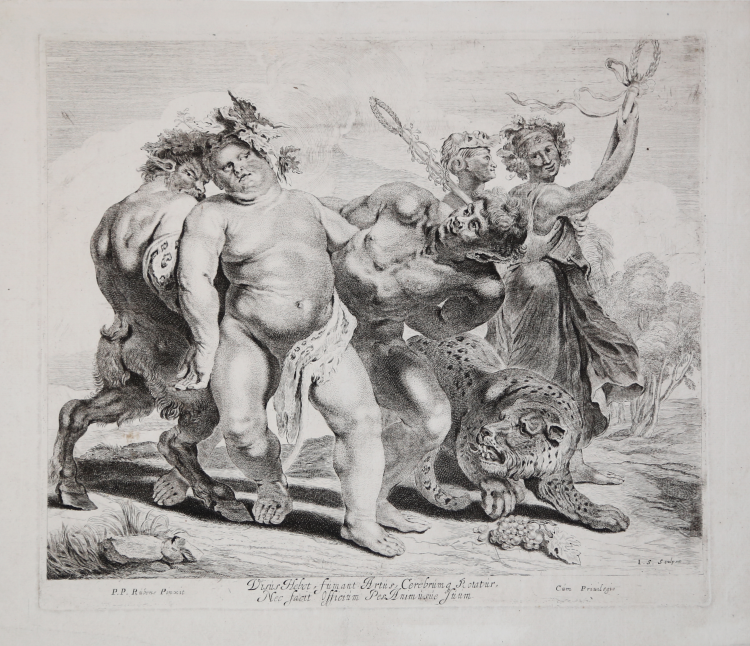




| Reference: | A50001 |
| Author | Jonas SUYDERHOEF |
| Year: | 1640 ca. |
| Measures: | 345 x 300 mm |



| Reference: | A50001 |
| Author | Jonas SUYDERHOEF |
| Year: | 1640 ca. |
| Measures: | 345 x 300 mm |
Drunkenness of Bacchus; the young god supported by two satyrs at centre, two Bacchants with staffs beyond, a leopard and a bunch of grapes at right; after Peter Paul Rubens
Engraving and etching, circa 1640, signed within image, in lower right: "I.S. Sculpsit". Lettered in lower margin with production details and two lines of Latin verses: "Visus Hebet, fumant Artus, Cerebrumque Rotatur, / Nec facit Officium Pes, Animusue suum" and "P. P. Rubens Pinxit" and "Cum Privilegio".
Example for the first state, before the address of Peter Soutman.
A fine impression, printed on contemporary laid paper with “shield with fleur-de-lys” watermark, with margins, very good condition.
Bibliografia
Hollstein, Dutch and Flemish etchings, engravings and woodcuts c.1450-1700 (6.I); Schneevoogt, Catalogue des estampes gravées d'après P.P.Rubens (133.124).
Jonas SUYDERHOEF (Haarlem 1613 – 1686)
|
Dutch etcher and engraver. He was the son of Andreas Pietersz. Suyderhoef, secretary to the first Dutch ambassador in Constantinople. A reproductive engraver with an oeuvre of some 138 prints, Jonas worked after the compositions of 50 or more different artists, including Anthony van Dyck, Frans Hals, Gerrit van Honthorst, Adriaen van Ostade, Rubens, Joachim von Sandrart and Gerard ter Borch the younger, as well as Caravaggio, Jan Lievens and Rembrandt.
Suyderhoef, in his prints after Hals, managed to imitate the effect of painted half-tones through his delicate handling of the etching needle. The subtle alternation of highlighted and shaded parts in these prints also contributes to the masterly rendering of Hals's broad touch. Suyderhoef tended to finish his plates off with the burin. As well as some 107 portraits, there is a group after genre compositions by Adriaen van Ostade, including several large prints.
Suyderhoef's latest dated print is a portrait of Noah Smaltius (1668; Hollstein, no. 118), after Johan Thopas (c. 1630-c. 1700). After 1664 Suyderhoef's name occurs repeatedly in the books of Haarlem's guild, of which he served as dean in 1678.
|
Jonas SUYDERHOEF (Haarlem 1613 – 1686)
|
Dutch etcher and engraver. He was the son of Andreas Pietersz. Suyderhoef, secretary to the first Dutch ambassador in Constantinople. A reproductive engraver with an oeuvre of some 138 prints, Jonas worked after the compositions of 50 or more different artists, including Anthony van Dyck, Frans Hals, Gerrit van Honthorst, Adriaen van Ostade, Rubens, Joachim von Sandrart and Gerard ter Borch the younger, as well as Caravaggio, Jan Lievens and Rembrandt.
Suyderhoef, in his prints after Hals, managed to imitate the effect of painted half-tones through his delicate handling of the etching needle. The subtle alternation of highlighted and shaded parts in these prints also contributes to the masterly rendering of Hals's broad touch. Suyderhoef tended to finish his plates off with the burin. As well as some 107 portraits, there is a group after genre compositions by Adriaen van Ostade, including several large prints.
Suyderhoef's latest dated print is a portrait of Noah Smaltius (1668; Hollstein, no. 118), after Johan Thopas (c. 1630-c. 1700). After 1664 Suyderhoef's name occurs repeatedly in the books of Haarlem's guild, of which he served as dean in 1678.
|